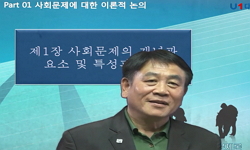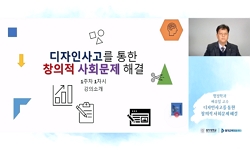In 17th century, there was a big changing as a development in Korean Novel history. In this time there were 17th century's representative writers and works these are Ilongkildongjeon (洪吉童傳) by Heo Gyun, Goowoonmong (九雲夢) and Sassinamieon...
http://chineseinput.net/에서 pinyin(병음)방식으로 중국어를 변환할 수 있습니다.
변환된 중국어를 복사하여 사용하시면 됩니다.
- 中文 을 입력하시려면 zhongwen을 입력하시고 space를누르시면됩니다.
- 北京 을 입력하시려면 beijing을 입력하시고 space를 누르시면 됩니다.
https://www.riss.kr/link?id=A60055645
- 저자
- 발행기관
- 학술지명
- 권호사항
-
발행연도
2012
-
작성언어
-
- 주제어
-
KDC
810
-
등재정보
KCI등재
-
자료형태
학술저널
- 발행기관 URL
-
수록면
51-78(28쪽)
-
KCI 피인용횟수
0
- 제공처
-
0
상세조회 -
0
다운로드
부가정보
다국어 초록 (Multilingual Abstract)
These works have very reality story compare with 17th century's works such as Geumosinwha(金鰲新話) and Keeiaekeei(企齋記異) which have romance and a wild fabte story. These works have been very developed than early works because they have social problem and realistic things as a story. Choicheokjeon have shown well sold at that time but other works could not find their works were real even though they have copied works.
Lee Minsung, who has lived with Choicheokjeon writer, has wrote he had been read Choicheokjeon in his book Gyoungjungjib(敬亭集) as showing this work was existed. Also it can see at the Kakgajabgi(各家雜記) by Jo Munmyung as a remaking form. Choicheokjeon could find as a novel form in Tongwonmoongo(通園文藁) by You Manjoo and Misanmoongo(糜山文藁) by Kim .Iinhang. Lee Dukmoo has written that he read it in his letter to his nephew.
Also in Korea(高麗), Secul(J,i%), Chulie(天理) Universities have it to the Chinese character form. And in Seonhyunyoueim(先賢遺音) could find its original text. It seem to well read to public because in Yonsei(~ilt) University has Korean style even though it is not perfect form.
Why does this book have been well read in every time? This book has very good story and can find writer has been trying to make this book to realistic form. It has times realistic and geographical background. It has historical story that has happened in that time. Also it is easy to find kind of that book's characters around our lives. It is not made by a wild fable story it is made by a causal relationship. As developing story, writer has written letter and poetic replying soene in his work. And in the behind soenes he has written his life and experience and in his work there is exact reason and time why he makes the story.
This book has clearly writer's idea and to the every where we can see well matched various characters to give more interesting. This book has many points it can not find to other books, it has included with realistic story with real happened problems, positive viewing to women even thought in male-dominated society, new family structures.
It is sure that makes 17th century novel improving. It is the leader not only 17th century, it is sure that is the leader in novel history. Choicheokjeon is clear that is best work after 17th century also I should be been important novel. Also writer Jo Wihan who has made this great work should be treated as a important writer.
In 17th century, there was a big changing as a development in Korean Novel history. In this time there were 17th century's representative writers and works these are Ilongkildongjeon (洪吉童傳) by Heo Gyun, Goowoonmong (九雲夢) and Sassinamieonggi(謝氏南征記) by Kim Manjoong, Gyechukilgee (癸丑日記) by who has served Inmok queen, Choicheokjeon by Jo Wihan. Changsungamuiitok(彰善感義錄) by Jo Secnggi, and Woonyoungjeon(雲英傳) by unnamed writer.
These works have very reality story compare with 17th century's works such as Geumosinwha(金鰲新話) and Keeiaekeei(企齋記異) which have romance and a wild fabte story. These works have been very developed than early works because they have social problem and realistic things as a story. Choicheokjeon have shown well sold at that time but other works could not find their works were real even though they have copied works.
Lee Minsung, who has lived with Choicheokjeon writer, has wrote he had been read Choicheokjeon in his book Gyoungjungjib(敬亭集) as showing this work was existed. Also it can see at the Kakgajabgi(各家雜記) by Jo Munmyung as a remaking form. Choicheokjeon could find as a novel form in Tongwonmoongo(通園文藁) by You Manjoo and Misanmoongo(糜山文藁) by Kim .Iinhang. Lee Dukmoo has written that he read it in his letter to his nephew.
Also in Korea(高麗), Secul(J,i%), Chulie(天理) Universities have it to the Chinese character form. And in Seonhyunyoueim(先賢遺音) could find its original text. It seem to well read to public because in Yonsei(~ilt) University has Korean style even though it is not perfect form.
Why does this book have been well read in every time? This book has very good story and can find writer has been trying to make this book to realistic form. It has times realistic and geographical background. It has historical story that has happened in that time. Also it is easy to find kind of that book's characters around our lives. It is not made by a wild fable story it is made by a causal relationship. As developing story, writer has written letter and poetic replying soene in his work. And in the behind soenes he has written his life and experience and in his work there is exact reason and time why he makes the story.
This book has clearly writer's idea and to the every where we can see well matched various characters to give more interesting. This book has many points it can not find to other books, it has included with realistic story with real happened problems, positive viewing to women even thought in male-dominated society, new family structures.
It is sure that makes 17th century novel improving. It is the leader not only 17th century, it is sure that is the leader in novel history. Choicheokjeon is clear that is best work after 17th century also I should be been important novel. Also writer Jo Wihan who has made this great work should be treated as a important writer.
목차 (Table of Contents)
- 1. 序言
- 2. 17世紀 小說文壇의 槪況
- 3. 作者 趙緯韓
- 4. 作品 崔陟傳
- 5. 結言
- 1. 序言
- 2. 17世紀 小說文壇의 槪況
- 3. 作者 趙緯韓
- 4. 作品 崔陟傳
- 5. 結言
- <참고문헌>
- [Abstract]
참고문헌 (Reference)
1 金安老, "龍泉談寂記"
2 양승민, "최척전의 창작동인과 소통과정" 韓國古小說學會 (9) : 67-113, 2000
3 이복규, "초기 국문․국문본 소설" 박이정 1998
4 김춘택, "우리나라 고전소설사" 한길사 1993
5 김진영, "고전소설의 전통과 변이" 태학사 2006
6 장효현, "韓國古典小說史硏究" 高麗大學校出版部 2002
7 李德懋, "靑莊館全書"
8 閔泳大, "趙緯韓의 삶과 문학" 국학자료원 2000
9 閔泳大, "趙緯韓과 崔陟傳" 亞細亞文化社 1993
10 權韠, "石洲集"
1 金安老, "龍泉談寂記"
2 양승민, "최척전의 창작동인과 소통과정" 韓國古小說學會 (9) : 67-113, 2000
3 이복규, "초기 국문․국문본 소설" 박이정 1998
4 김춘택, "우리나라 고전소설사" 한길사 1993
5 김진영, "고전소설의 전통과 변이" 태학사 2006
6 장효현, "韓國古典小說史硏究" 高麗大學校出版部 2002
7 李德懋, "靑莊館全書"
8 閔泳大, "趙緯韓의 삶과 문학" 국학자료원 2000
9 閔泳大, "趙緯韓과 崔陟傳" 亞細亞文化社 1993
10 權韠, "石洲集"
11 趙緯韓, "玄谷集"
12 金東旭, "洪吉童傳의 比較文學的 考察, In 許筠의 文學과 革新思想" 새문사 86-111, 1981
13 李安訥, "東岳集"
14 "朝鮮王朝實錄"
15 閔泳大, "朝鮮時代宮中小說硏究" 亦樂 2004
16 朴忠祿, "朝鮮古典文學選集(8), In 林悌權鞸作品選" 民族出版社 1987
17 洪萬宗, "旬五志"
18 柳夢寅, "於于野談"
19 李民宬, "敬亭集"
20 許筠, "惺所覆瓿稿"
21 國語國文學會, "原文漢文小說選" 大提閣 1976
22 簡鎬允, "先賢遺音" 이회 2003
23 蘇在英, "企齋記異硏究" 高麗大學校民族文化硏究所 1990
24 方賓觀, "中國古今地名大辭典" 臺灣商務印書館 1979
25 양승민, "17세기 전기소설의 통속화 경향과 그 소설사적 의미" 고려대학교 대학원 2003
26 이상구, "17세기 애정전기소설" 圖書出版月印 1999
27 소인호, "17세기 고전소설의 저작 유통과 화몽집의 소설사적 위상" 한국고소설학회 (21) : 277-310, 2006
동일학술지(권/호) 다른 논문
-
- 한국언어문학회
- 신희교(Sin,Hui-gyo)
- 2012
- KCI등재
-
- 한국언어문학회
- 김수중(Kim, Su-jung)
- 2012
- KCI등재
-
- 한국언어문학회
- 최은영(Choi, Eun-young)
- 2012
- KCI등재
-
- 한국언어문학회
- 임철호(Lim,Cheol-ho)
- 2012
- KCI등재
분석정보
인용정보 인용지수 설명보기
학술지 이력
| 연월일 | 이력구분 | 이력상세 | 등재구분 |
|---|---|---|---|
| 2028 | 평가예정 | 재인증평가 신청대상 (재인증) | |
| 2022-01-01 | 평가 | 등재학술지 유지 (재인증) |  |
| 2019-01-01 | 평가 | 등재학술지 유지 (계속평가) |  |
| 2016-01-01 | 평가 | 등재학술지 선정 (계속평가) |  |
| 2015-12-01 | 평가 | 등재후보로 하락 (기타) |  |
| 2011-01-01 | 평가 | 등재학술지 유지 (등재유지) |  |
| 2009-01-01 | 평가 | 등재학술지 유지 (등재유지) |  |
| 2007-01-01 | 평가 | 등재학술지 유지 (등재유지) |  |
| 2005-01-01 | 평가 | 등재학술지 유지 (등재유지) |  |
| 2002-01-01 | 평가 | 등재학술지 선정 (등재후보2차) |  |
| 1999-07-01 | 평가 | 등재후보학술지 선정 (신규평가) |  |
학술지 인용정보
| 기준연도 | WOS-KCI 통합IF(2년) | KCIF(2년) | KCIF(3년) |
|---|---|---|---|
| 2016 | 0.31 | 0.31 | 0.28 |
| KCIF(4년) | KCIF(5년) | 중심성지수(3년) | 즉시성지수 |
| 0.3 | 0.32 | 0.556 | 0.11 |




 스콜라
스콜라






